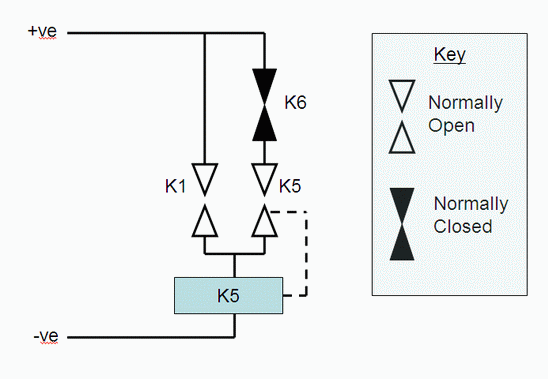|
|
 
|
|
Author
|
Topic: difference beteween "latch" and "activated" in relay terms
|
|
|
|
|
|
|
|
|
|
|
Randy Stankey
Film God

Posts: 6539
From: Erie, Pennsylvania
Registered: Jun 99
|
 posted 09-27-2004 11:27 PM
posted 09-27-2004 11:27 PM




Yeah! What they said! ![[Smile]](smile.gif)
Your average relay simply closes the contact(s) when you energize the coil. As soon as the coil is de-energized the contacts go back to their "normal" state.
Some relays, however, have a latch built into them. Yes, the contacts stay closed even after the coil is de-energized. In order to get the contacts to open or go back to "normal" state you have to energize ANOTHER coil to release the latch.
You can imagine how it would be unweildly to keep a relay energized for 2 hours or more in order to keep something like a projector motor running for an entire show. A latching relay can solve this problem.
"Latching" is also way to refer to a multi-pole relay where one set of contacts from the energized/closed state is wired in parallel with the switch that closes to energize the coil. This will KEEP the coil energized until the power is removed.
Take a N+1 Pole relay of sufficient spec to control your load. (I'd go a size bigger if I could... Just for luck.) Wire a SPST toggle switch and a SPST/NO pushbutton switch in series to the coil. (And the power source for the coil.) Take the extra contact on the relay and wire it back so that it's in parallel with the SPST/NO pushbutton.
When the toggle switch is closed, then the pushbutton is pressed, the coil will be energized and the contacts will close. Your load will be powered. That extra set of contacts that you wired back to the pushbutton will KEEP power going to the coil as long as the toggle is still closed.
Let's say you had a simple set up that just needed to operate a projector motor and a lamphouse contactor. You'd need a 3-Pole relay that coule handle the load of the projector motor and the lamphouse without burning up. Wire everything up with due care. Use a simple 120v/12v transformer to power your coil. Wire your projector's failsafe in series with the toggle switch. Put a 12v lamp in there if you want to.
Now, you thread your projector and make sure the failsafe is up. (Contatcts closed.) When it's time to start the show, close the toggle switch and press the button. Your machine will run until:
A) The film runs out.
B) The film breaks.
C) You open the "Kill Switch".
This is the exact setup I had on my projector at Mercyhurst before we got the automation system. I had one of those remote starter buttons you get from an auto parts store to turn on the sound. I shaved the sprocket holes off a piece of black leader about 15 feet long. (Only one side.) When the shaved film went through the failsafe, the arm would drop and the projector would coast to a stop with the black film still in the gate.
It looked almost like I had a real automation system... But it was a LOT of work...
Press the START button.
Open the dowser.
Click the sound on.
Focus, etc.
Turn the lights down.
Then PRAY everything held together! ![[Wink]](wink.gif)
Do it all in reverse when the show was over!
You had to check the system frequently! Putting on a show was a lot of work until the automation came!
Be glad you have automation!
| IP: Logged
|
|
|
|
|
|
|
|
Randy Stankey
Film God

Posts: 6539
From: Erie, Pennsylvania
Registered: Jun 99
|
 posted 09-28-2004 11:58 PM
posted 09-28-2004 11:58 PM




Sounds like it could be either. It could be a latching relay or it could be a relay wired-up to latch.
I'm going to guess that it's the first one. It's a latching relay.
Here's how I parse your sentence:
Relay "K1" energizes and causes "K5" to energize, close contacts and latch.
It stays closed until "K6" energizes.
The function of "K5" is to open the non-sync circuit and provide 12 VAC to other components farther down the line.
***
At the point where I first jumped in, I read other peoples' answers which pretty much answered the question as it was first posed: What is a "latched" relay? Steve and I added more information on different ways a relay could be made to latch and how one might use a latching relay in a real-life situation.
Maybe you're right, Mark, that mine is a case of "too much information". But, my goal was to give enough general information so that the original poster could apply the knowledge to his own situation. Was my answer too difficult to understand?
***
Steve,
I agree that a relay wired in latching mode is used often to good effect and there are few problems but I meant that the situation CAN BECOME unweildy in some cases. A 3 phase contactor to turn on a lamphouse power supply is OK because you're using a relatively small amount of electricity to control quite a large amount of electricity. If you had a latching relay that used a relatively large amount of electricity to control a small amount, things would be unweildy. (Unless you had a good reason.) Further, if your power fluctuated, the relay could open on you when you didn't want it. If the latching contact got worn out or pitted/burned, the relay wouldn't reliably stay latched.
If any of those situations would cause undesireable results, don't use a relay that's WIRED to latch. Use one that latches itself or find another way around the problem.
| IP: Logged
|
|
William Hooper
Phenomenal Film Handler
Posts: 1879
From: Mobile, AL USA
Registered: Jun 99
|
 posted 09-29-2004 12:41 AM
posted 09-29-2004 12:41 AM





quote: Philip Wittlief
K5 HOLD RELAY 4PDT, LATCHES via K6, Activated by K1, stays latched until K6 activates Opens Non-Sync Circuit when latched, provides 12 VAC to POWER relay K12, and K9, K10 and term. 8
That's really ambiguously written, & the kind of thing that makes you go "@%&*!, got to pull out the schematic & look at it!"
Relays in some equipment are implemented be utilized as latched (continuous contact) or momentary, depending on how they're activated, or set up with jumpers, etc.
That description could mean that K5 is momentary, but can be latched by K6. K6 latching function or K5 momentary is activated by K1 (ambiguous). Then it opens again when K6 is activated.
Is there a period missing in there: "...until K6 activates(.) Opens Non-Sync Circuit.." ?
If so, the part beginning "Opens Non-Sync Circut.." does not describe how K5 is latched, but just describes what K5 does.
My "guess & see if it burns up" idea would be that K1 activates K5, & K5 is (automatically) latched by K6. It stays latched until K6 activates.
| IP: Logged
|
|
David Buckley
Jedi Master Film Handler
Posts: 525
From: Oxford, N. Canterbury, New Zealand
Registered: Aug 2004
|
 posted 09-29-2004 07:11 AM
posted 09-29-2004 07:11 AM





Late reply, but...
K5 HOLD RELAY 4PDT, LATCHES via K6, Activated by K1, stays latched until K6 activates
Here we go then

K1 and K6 are normally open relays, and K5 is wired as a latcher.
When you activate K1, relay K5 will latch. (You could also say it activates, but the latching behaviour overrides that terminology). K5 will stay that way until (a) the power fails, or (b) relay K6 is activated.
As was pointed out earlier, the trick to electrically latching a relay is to have a set of normally open contacts on the latching relay able to supply power to the coil. Once that relay is activated, somehow, anyhow, it will stay latched. Placing additional contacts or switches in series with the latch circuit can modify this behaviour, as you have, to effect a release, or to even make the circuit non-latchable.
When I said somehow, anyhow, just above, the activation does not need to be electrical - it could be mechanical. You get latching panel buttons that work exactly the same way.
And those big direct-on-line starters you see on workshop walls, with the green and red buttons - they have the exact same circuit configuation.
Now can someone tell the newbie what an ID frame is?
| IP: Logged
|
|
|
|
|
|
All times are Central (GMT -6:00)
|
|
Powered by Infopop Corporation
UBB.classicTM
6.3.1.2
The Film-Tech Forums are designed for various members related to the cinema industry to express their opinions, viewpoints and testimonials on various products, services and events based upon speculation, personal knowledge and factual information through use, therefore all views represented here allow no liability upon the publishers of this web site and the owners of said views assume no liability for any ill will resulting from these postings. The posts made here are for educational as well as entertainment purposes and as such anyone viewing this portion of the website must accept these views as statements of the author of that opinion
and agrees to release the authors from any and all liability.
|

 Home
Home
 Products
Products
 Store
Store
 Forum
Forum
 Warehouse
Warehouse
 Contact Us
Contact Us




 Printer-friendly view of this topic
Printer-friendly view of this topic










![[Smile]](smile.gif)
![[Wink]](wink.gif)





